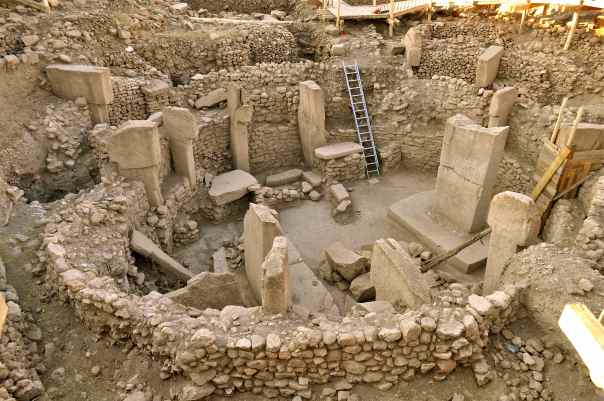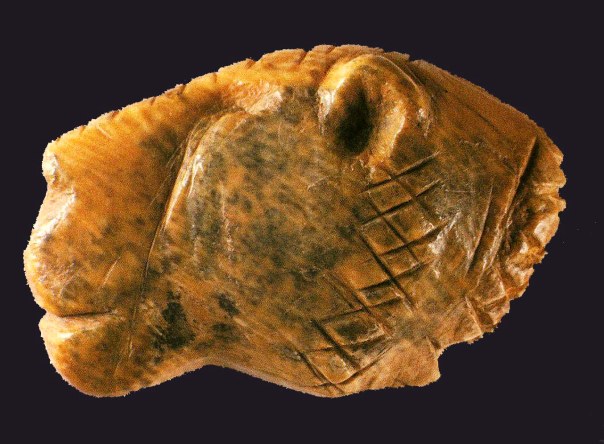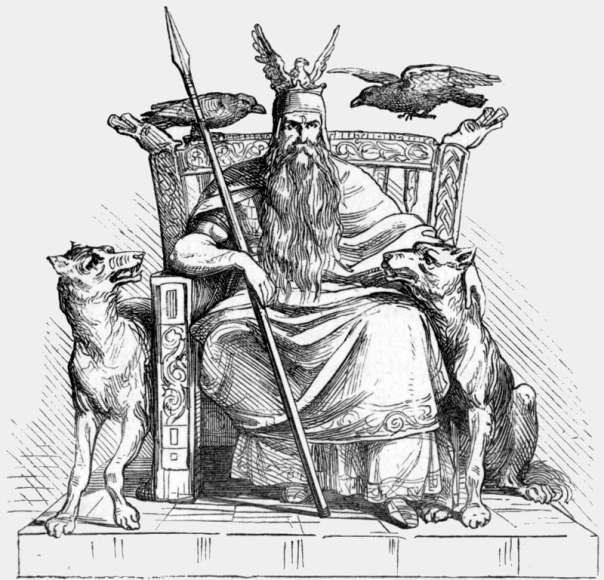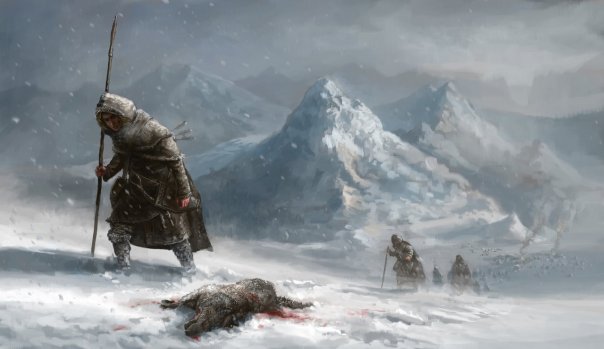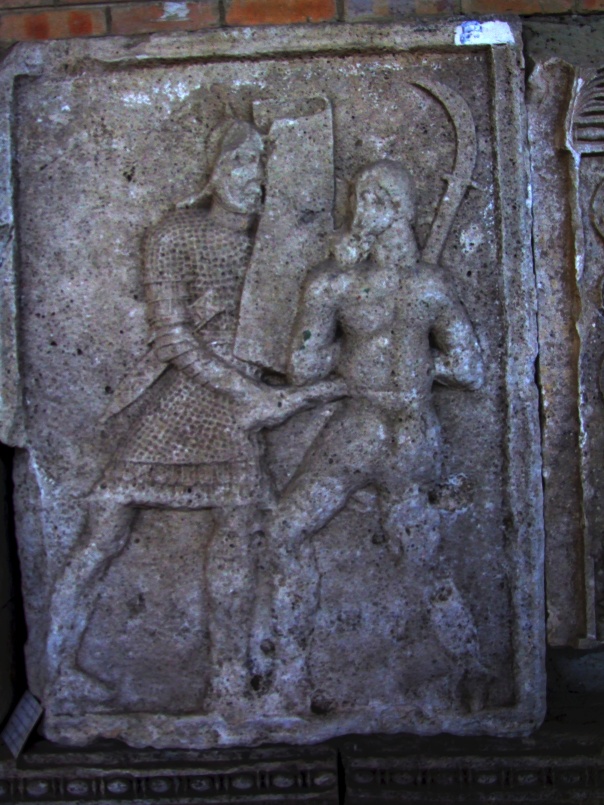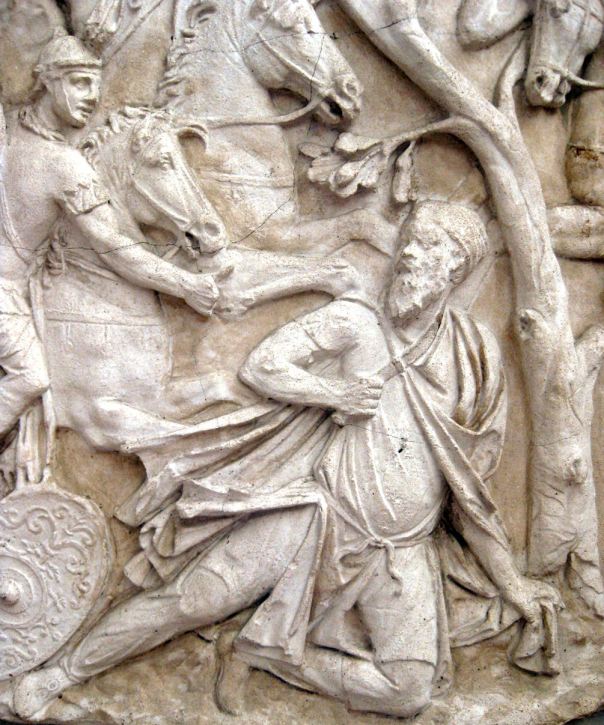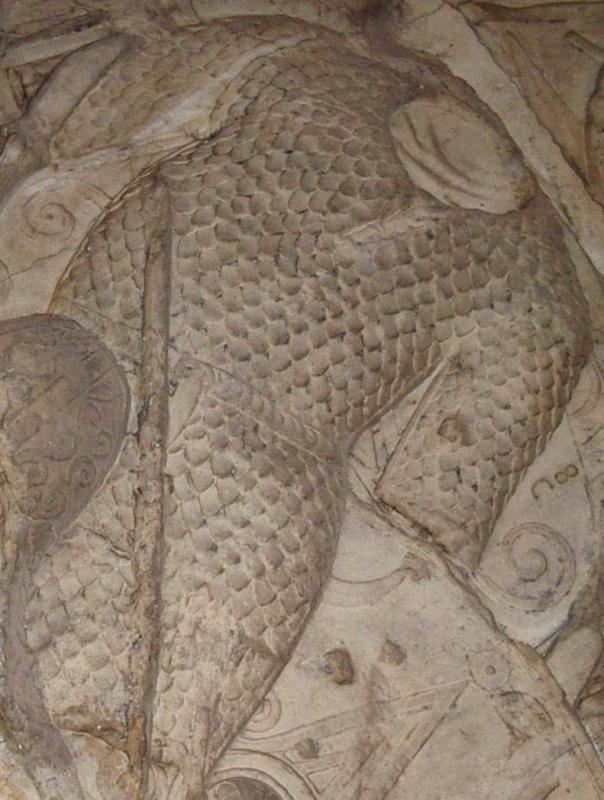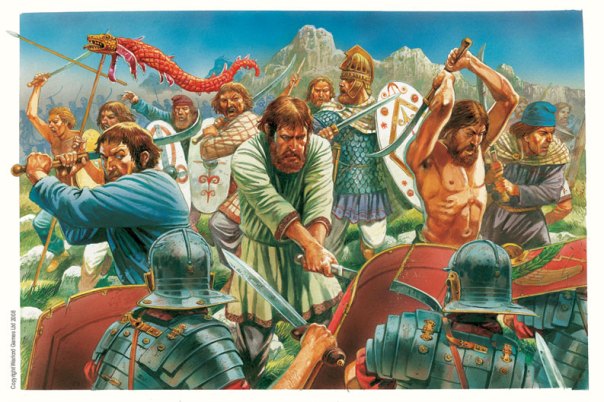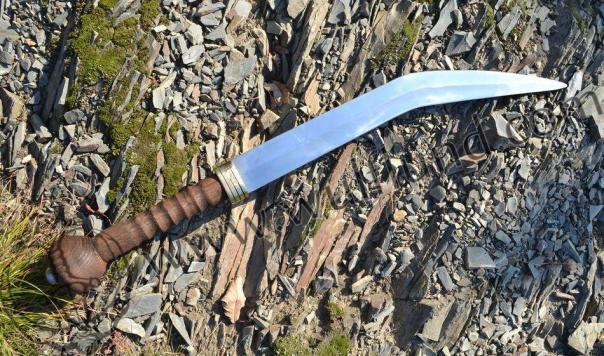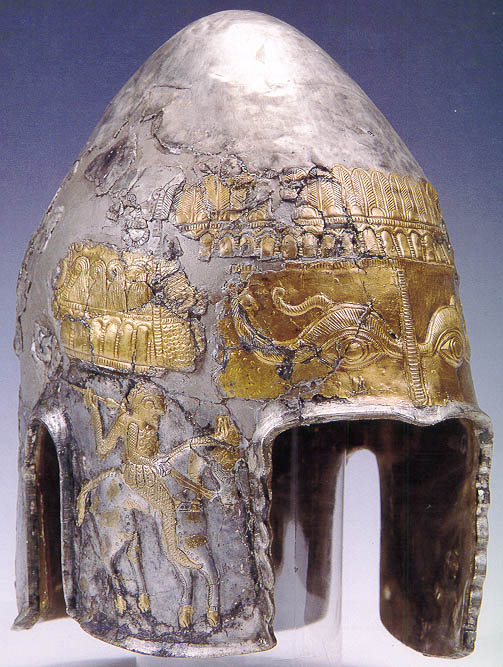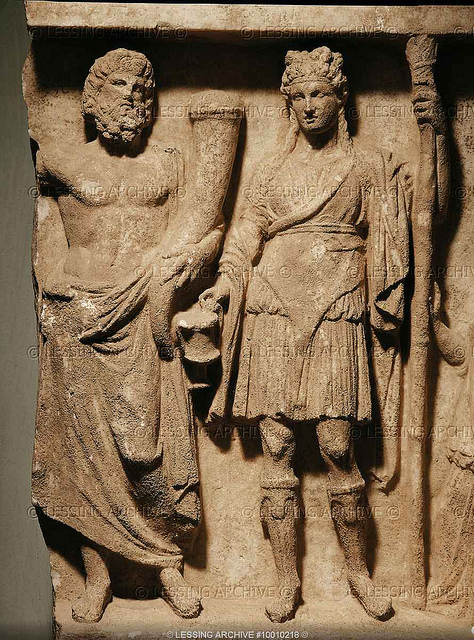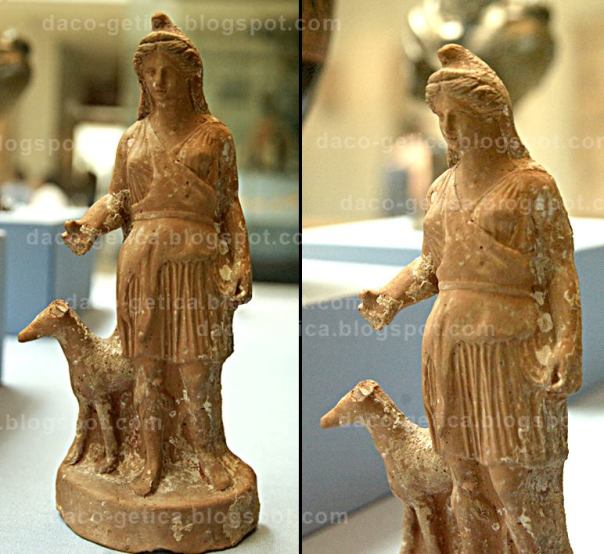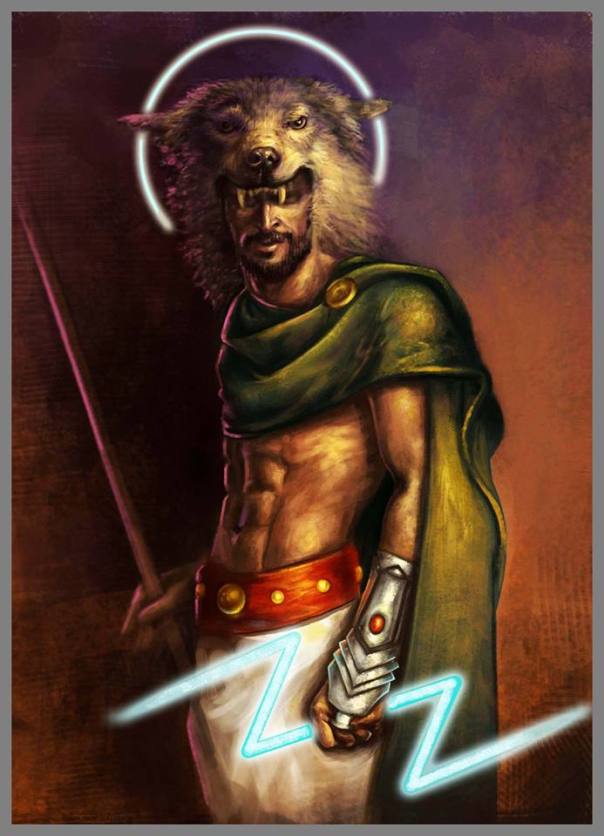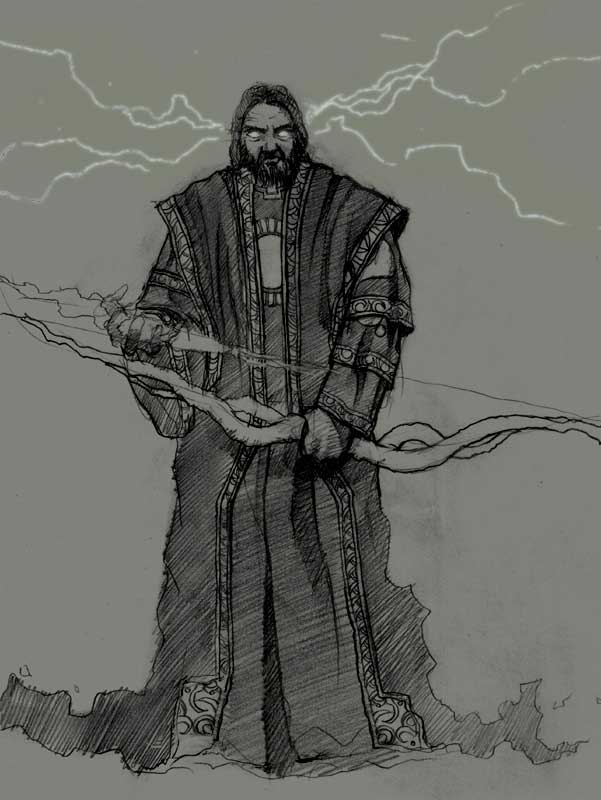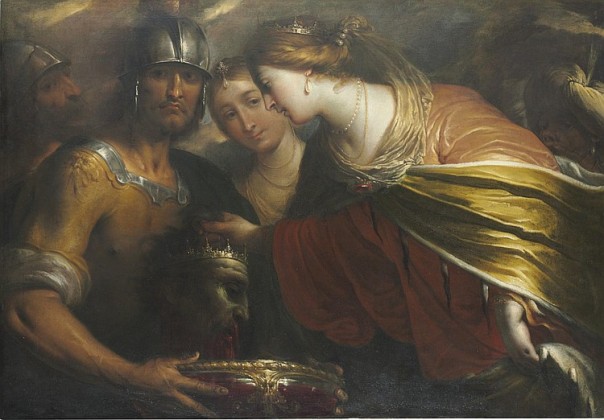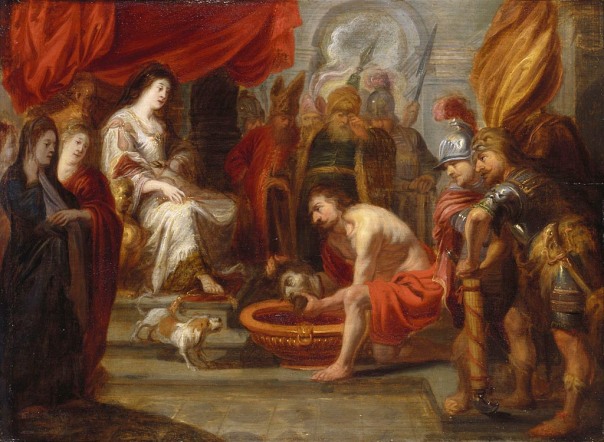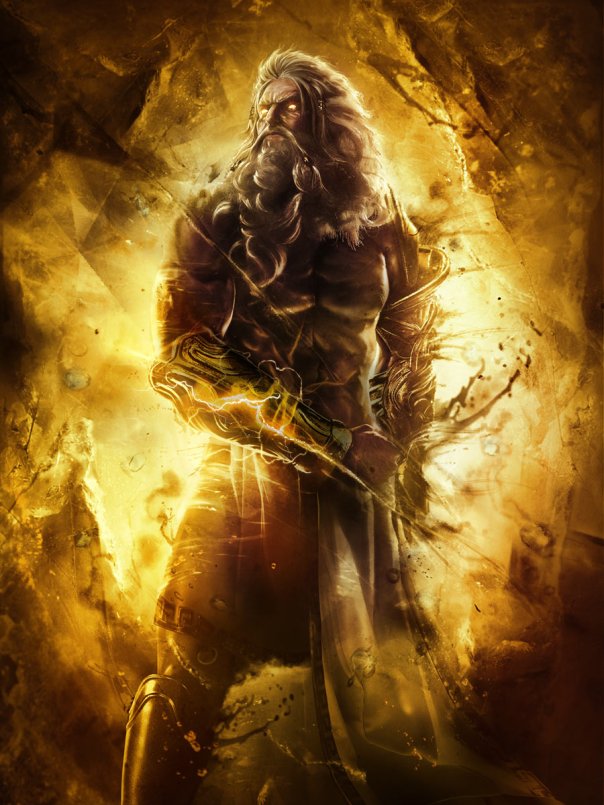The Beautiful Laws of Zalmoxis
~
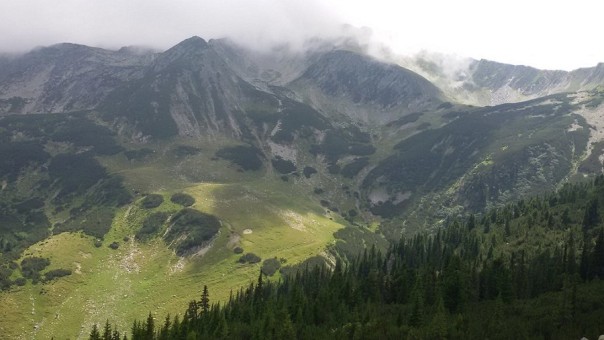
~
Credit For Translation of these Laws from Romanian into English : Licantrop Alex
~
Dincolo de curgerea timpului si de cugetarea zeilor, este Focul cel Viu si Vesnic, din care vin toate si prin care fiinteaza toate cele ce sunt. Totul si nimicul sunt suflarea Sa, golul si plinul sunt mainile Sale, miscarea si nemiscarea sunt picioarele Sale, nicaieri si peste tot este mijlocul Sau, iar chipul Sau este lumina. Nimic nu este faptuit fara de lumina si tot ce vine din lumina prinde viata si ia faptura.
#
Beyond the flow of time and the cogitation of the gods, there is the Living and eternal Fire, from which all come and make all that which is. Everything and nothing are it’s breath, the empty and the full are It’s hands, movement and stillness are it’s legs, nowhere and everywhere are It’s middle, and it’s face (image) is light, nothing is made without light and all that comes from light becomes alive and comes into being.
conceit, because that’s where your roots are (also talks about animals, our roots are there, those who hate animals hate their roots and their own nature), and to those who are above you, look upon them with the sight of a child and without fear.
Were There Gods Before the Time of the Garden of Eden ?
~

A few dozen documented Neanderthal burials from Western Europe, Eastern Europe and Southwest Asia have already been documented.
~
Did Neanderthals believe in an afterlife?
http://news.discovery.com/history/archaeology/neanderthal-burial-ground-afterlife-110420.htm
THE GIST
– Neanderthal skeletons found in apparent burial poses have been unearthed at a site in Spain.
– The site, Sima de las Palomas, may be the first known Neanderthal burial ground of Mediterranean Europe.
– Remains for six to seven other Neanderthals, including an infant and two juveniles, as well as associated tools and food, have also been excavated.
Evidence for a likely 50,000-year-old Neanderthal burial ground that includes the remains of at least three individuals has been unearthed in Spain, according to a Quaternary International paper.
The deceased appear to have been intentionally buried, with each Neanderthal’s arms folded such that the hands were close to the head. Remains of other Neanderthals have been found in this position, suggesting that it held meaning.
Neanderthals therefore may have conducted burials and possessed symbolic thought before modern humans had these abilities. The site, Sima de las Palomas in Murcia, Southeast Spain, may also be the first known Neanderthal burial ground of Mediterranean Europe.
“We cannot say much (about the skeletons) except that we surmise the site was regarded as somehow relevant in regard to the remains of deceased Neanderthals,” lead author Michael Walker told Discovery News. “Their tools and food remains, not to mention signs of fires having been lit, which we have excavated indicate they visited the site more than once.”
Walker, a professor in the Department of Zoology and Physical Anthropology at the University of Murcia, and his colleagues have been working at the site for some time. So far they have found buried articulated skeletons for a young adult female, a juvenile or child, and an adult — possibly male — Neanderthal.
“We cannot say whether these three individuals were related, though it is likely,” he said, explaining that DNA has been denatured due to high ambient temperatures. “Surely the child was related to one of the others, though.”
The three skeletons represent some of the best-preserved, and most methodically excavated remains of Neanderthals.
“Such discoveries are extraordinarily uncommon,” Walker said.
The Neanderthals were found covered together with rocks burying their remains. The researchers believe it’s likely that other Neanderthals intentionally placed the rocks over the bodies from a height. While it cannot be ruled out that an accident killed the three individuals, the scientists believe that wasn’t the case.
“I think there is just enough evidence at Sima de las Palomas to think that three articulated skeletons are unlikely to have been the result of a single random accident to three cadavers that somehow escaped the ravages of hyenas and leopards, which were present at the site,” Walker said.
Unburnt bones of two articulated panther paws were embedded in rock “in an area where the rest of the animal’s skeleton was conspicuous by its absence notwithstanding its proximity to the human skeletons,” the authors write.
The researchers speculate that a Neanderthal cut off the panther paws and kept them. It is also possible that the paws were added to the bodies before burial, perhaps holding some ritual significance.
The remains of six to seven other Neanderthals, including one baby and two juveniles, have also been excavated at the site. The tallest individual appears to have been an adult who stood around 5’1″.
Erik Trinkaus, a professor of physical anthropology at Washington University in St. Louis, is one of the world’s leading experts on Neanderthals. He told Discovery News that “it is certainly possible that they (the Neanderthals at Sima de las Palomas) were buried.”
He said a few dozen documented Neanderthal burials from Western Europe, Eastern Europe and Southwest Asia have already been documented.
Trinkaus added that the Neanderthal remains from Spain will “provide us with our first glimpse of overall Neanderthal body form in Southern Europe, as well as additional specimens for a number of aspects of Neanderthal biology.”
~
~
Göbekli Tepe
Göbekli Tepe (Turkish: [ɡøbe̞kli te̞pɛ],[2] “Potbelly Hill”[3]) is an archaeological site at the top of a mountain ridge in the Southeastern Anatolia Region of Turkey, approximately 12 km (7 mi) northeast of the city of Şanlıurfa. The tell has a height of 15 m (49 ft) and is about 300 m (984 ft) in diameter.[4] It is approximately 760 m (2,493 ft) above sea level. It has been excavated by a German archaeological team that was under the direction of Klaus Schmidt from 1996 until his death in 2014.
The tell includes two phases of ritual use dating back to the 10th-8th millennium BCE. During the first phase (Pre-Pottery Neolithic A (PPNA)), circles of massive T-shaped stone pillars were erected. More than 200 pillars in about 20 circles are currently known through geophysical surveys. Each pillar has a height of up to 6 m (20 ft) and a weight of up to 20 tons. They are fitted into sockets that were hewn out of the bedrock.[5] In the second phase (Pre-pottery Neolithic B (PPNB)), the erected pillars are smaller and stood in rectangular rooms with floors of polished lime. Topographic scans have revealed that other structures next to the hill, awaiting to be excavated, probably date to 14-15 thousand years ago.[6] The site was abandoned after the PPNB-period. Younger structures date to classical times.
The function of the structures is not yet clear. Excavator Klaus Schmidt believed that they are early neolithic sanctuaries.
Discovery
The site was first noted in a survey conducted by Istanbul University and the University of Chicago in 1963. American archaeologist Peter Benedict identified it as being possibly neolithic[7] and postulated that the Neolithic layers were topped by Byzantine and Islamic cemeteries. The survey noted numerous flints. Huge limestone slabs, upper parts of the T-shaped pillars, were thought[by whom?] to be grave markers. The hill had long been under agricultural cultivation, and generations of local inhabitants had frequently moved rocks and placed them in clearance piles, possibly destroying archaeological evidence in the process.
In 1994, Klaus Schmidt, of the German Archaeological Institute, who had previously been working at Nevalı Çori, was looking for another site to lead a dig. He reviewed the archaeological literature on the surrounding area, found the Chicago researchers’ brief description of Göbekli Tepe, and decided to give it another look. With his knowledge of comparable objects at Nevalı Çori, he recognized the possibility that the rocks and slabs were parts of T-shaped pillars.
The following year, he began excavating there in collaboration with the Şanlıurfa Museum. Huge T-shaped pillars were soon discovered. Some had apparently been subjected to attempts at smashing, probably by farmers who mistook them for ordinary large rocks.[8] The nearby Gürcütepe site – also Neolithic – was not excavated until 2000.[9]
Dating
The imposing stratigraphy of Göbekli Tepe attests to many centuries of activity, beginning at least as early as the epipaleolithic period. Structures identified with the succeeding period, Pre-Pottery Neolithic A (PPNA), have been dated to the 10th millennium BCE. Remains of smaller buildings identified as Pre-Pottery Neolithic B (PPNB) and dating from the 9th millennium BCE have also been unearthed.
A number of radiocarbon dates have been published. They are reproduced below with one standard deviation errors, calibrated to the BCE:
.
| Lab-Number | Date BP | Cal BCE | Context |
|---|---|---|---|
| Ua-19561 | 8430 ± 80 | 7560–7370 | enclosure C |
| Ua-19562 | 8960 ± 85 | 8280–7970 | enclosure B |
| Hd-20025 | 9452 ± 73 | 9110–8620 | Layer III |
| Hd-20036 | 9559 ± 53 | 9130–8800 | Layer III |
.
The Hd samples are from charcoal in the lowest levels of the site and would date the active phase of occupation. The Ua samples come from pedogenic carbonate coatings on pillars and only indicate a time after the site was abandoned—the terminus ante quem.[10]
The complex
Göbekli Tepe is situated on a flat and barren plateau, with buildings fanning in all directions. In the north, the plateau is connected to a neighbouring mountain range by a narrow promontory. In all other directions, the ridge descends steeply into slopes and steep cliffs.[11] On top of the ridge, there is considerable evidence of human impact in addition to the actual tell. Excavations have taken place at the southern slope of the tell, south and west of a mulberry that marks an Islamic pilgrimage,[12] but archaeological finds come from the entire plateau. The team has also found many remains of tools.
Plateau
The plateau has been transformed by erosion and by quarrying, which took place not only in the Neolithic, but also in classical times. There are four 10 m (33 ft) long and 20 cm (8 in) wide channels on the southern part of the plateau, interpreted as the remains of an ancient quarry from which rectangular blocks were taken. These are possibly related to a square building in the neighbourhood, of which only the foundation is preserved. Presumably, this is the remains of a Roman watchtower which belonged to the Limes Arabicus. However, this is not known with certainty.[13]
Most structures on the plateau seem to be the result of Neolithic quarrying, with the quarries being used as sources for the huge, monolithic architectural elements. Their profiles were pecked into the rock, with the detached blocks then levered out of the rock bank.[13] Several quarries where round workpieces had been produced were identified. Their status as quarries was confirmed by the find of a 3-by-3-metre piece at the southeastern slope of the plateau. Unequivocally Neolithic are three T-shaped pillars that have not been levered out of the bedrock. The biggest of them lies on the northern plateau. It has a length of 7 m (23 ft) and its head has a width of 3 m (10 ft). Its weight may be around 50 tons. The two other unfinished pillars lie on the southern Plateau.
At the western edge of the hill, a lion-like figure was found. In this area, flint and limestone fragments occur more frequently. It was therefore suggested that this could have been some kind of sculpture workshop.[14] It is unclear, on the other hand, how to classify three phallic depictions from the surface of the southern plateau. They are near the quarries from classical times, making their dating difficult.[15]
Apart from the tell, there is an incised platform with two sockets that could have held pillars, and a surrounding flat bench. This platform corresponds to the complexes from Layer III at the actual tell. Continuing the naming pattern, it is called “complex E.” Owing to its similarity to the cult-buildings at Nevalı Çori it has also been called “Temple of the Rock.” Its floor has been carefully hewn out of the bedrock and smoothed, reminiscent of the terrazzo floors of the younger complexes at Göbekli Tepe. Immediately northwest of this area are two cistern-like pits, believed to be part of complex E. One of these pits has a table-high pin as well as a staircase with five steps.[16]
At the western escarpment, a small cave has been discovered in which a small relief depicting a bovine was found. It is the only relief found in this cave.[17]
Layer III
At this early stage of the site’s history, circular compounds or temenoi first appear. They range from 10 to 30 metres in diameter. Their most notable feature is the presence of T-shaped limestone pillars evenly set within thick interior walls composed of unworked stone. Four such circular structures have been unearthed so far. Geophysical surveys indicate that there are 16 more, enclosing up to eight pillars each, amounting to nearly 200 pillars in all. The slabs were transported from bedrock pits located approximately 100 metres (330 ft) from the hilltop, with workers using flint points to cut through the limestone bedrock.[18]
Two taller pillars stand facing one another at the centre of each circle. Whether the circles were provided with a roof is uncertain. Stone benches designed for sitting are found in the interior.[19] Many of the pillars are decorated with abstract, enigmatic pictograms and carved animal reliefs. The pictograms may represent commonly understood sacred symbols, as known from Neolithic cave paintings elsewhere. The reliefs depict mammals such as lions, bulls, boars, foxes, gazelles and donkeys; snakes and other reptiles, arthropods such as insects and arachnids; and birds, particularly vultures. At the time the edifice was constructed, the surrounding country was likely to have been forested and capable of sustaining this variety of wildlife, before millennia of settlement and cultivation led to the near–Dust Bowl conditions prevalent today.[8] Vultures also feature prominently in the iconography of Çatalhöyük and Jericho. It is believed that in the early Neolithic culture of Anatolia and the Near East the deceased were deliberately exposed in order to be excarnated by vultures and other carrion birds. (The head of the deceased was sometimes removed and preserved — possibly a sign of ancestor worship.)[20] This, then, would represent an early form of sky burial, as still practiced by Tibetan Buddhists and by Zoroastrians in Iran and India.[21]
Few humanoid figures have surfaced at Göbekli Tepe. However, some of the T-shaped pillars have human arms carved on their lower half, suggesting that they are intended to represent the bodies of stylized humans (or perhaps gods). Loincloths also appear on the lower half of a few pillars. The horizontal stone member on top is thought to symbolize a human head. The pillars as a whole therefore have an anthropomorphic identity.[22] Whether they were intended to serve as surrogate worshippers, symbolize venerated ancestors, or represent supernatural, anthropomorphic beings is not clear.
At Pillar 27, Enclosure 2, Layer III, the discovery of a predator—a crocodile, or perhaps a leopard, built low to the ground, very muscular, shown with teeth bared and distinguished by a long tail that nearly doubles back on itself—has excited particular interest for being carved almost in the round, hinting at a degree of artistic training and division of labor that is again surprising, if not impossible, in a hunter-gatherer society.
Some of the floors in this, the oldest, layer are made of terrazzo (burnt lime), others are bedrock from which pedestals to hold the large pair of central pillars were carved in high relief.[23] Radiocarbon dating places the construction of these early circles in the range of 9600 to 8800 BC. Carbon dating suggests that (for reasons unknown) the enclosures were backfilled during the Stone Age.
Layer II
Creation of the circular enclosures in layer III later gave way to the construction of small rectangular rooms in layer II. Rectangular buildings make a more efficient use of space compared with circular structures. They are often associated with the emergence of the Neolithic.[24] But the T-shaped pillars, the main feature of the older enclosures, are also present here, indicating that the buildings of Layer II continued to serve as sanctuaries.[25] Layer II is assigned to Pre-Pottery Neolithic B (PPNB). The several adjoining rectangular, doorless and windowless rooms have floors of polished lime reminiscent of Roman terrazzo floors. Carbon dating has yielded dates between 8800 and 8000 BCE.[26] Several T-pillars up to 1.5 meters tall occupy the center of the rooms. A pair decorated with fierce-looking lions is responsible for the name “lion pillar building” by which their enclosure is known.[27]
Layer I
Layer I is the uppermost part of the hill. It is the shallowest, but accounts for the longest stretch of time. It consists of loose sediments caused by erosion and the virtually uninterrupted use of the hill for agricultural purposes since it ceased to operate as a cult center.
The site was deliberately backfilled sometime after 8000 BCE: the buildings were buried under debris, mostly flint gravel, stone tools, and animal bones that must have been imported from elsewhere.[28] In addition to Byblos points (weapon heads, i.e. arrowheads etc.) and numerous Nemrik points, Helwan-points and Aswad-points dominate the backfill’s lithic inventory.
Chronological context
All statements about the site must be considered preliminary, as less than 5% of the site has been excavated, and Schmidt planned to leave much of it untouched to be explored by future generations (when archaeological techniques will presumably have improved).[8] While the site formally belongs to the earliest Neolithic (PPNA), up to now no traces of domesticated plants or animals have been found. The inhabitants are assumed to have been hunters and gatherers who nevertheless lived in villages for at least part of the year.[29] So far, very little evidence for residential use has been found. Through the radiocarbon method, the end of Layer III can be fixed at about 9000 BCE (see above) but it is believed that the elevated location may have functioned as a spiritual center by 11,000 BCE or even earlier.
The surviving structures, then, not only predate pottery, metallurgy, and the invention of writing or the wheel, they were built before the so-called Neolithic Revolution, i.e., the beginning of agriculture and animal husbandry around 9000 BCE. But the construction of Göbekli Tepe implies organization of an advanced order not hitherto associated with Paleolithic, PPNA, or PPNB societies. Archaeologists estimate that up to 500 persons were required to extract the heavy pillars from local quarries and move them 100–500 meters (330–1,640 ft) to the site.[30] The pillars weigh 10–20 metric tons (10–20 long tons; 11–22 short tons), with one still in the quarry weighing 50 tons.[31] It has been suggested that an elite class of religious leaders supervised the work and later controlled whatever ceremonies took place. If so, this would be the oldest known evidence for a priestly caste—much earlier than such social distinctions developed elsewhere in the Near East.[8]
Around the beginning of the 8th millennium BCE Göbekli Tepe (“Potbelly Hill”) lost its importance. The advent of agriculture and animal husbandry brought new realities to human life in the area, and the “Stone-age zoo” (Schmidt’s phrase applied particularly to Layer III, Enclosure D) apparently lost whatever significance it had had for the region’s older, foraging communities. But the complex was not simply abandoned and forgotten to be gradually destroyed by the elements. Instead, each enclosure was deliberately buried under as much as 300 to 500 cubic meters (390 to 650 cu yd) of refuse consisting mainly of small limestone fragments, stone vessels, and stone tools. Many animal, even human, bones have also been identified in the fill.[32] Why the enclosures were buried is unknown, but it preserved them for posterity.
Interpretation
Schmidt’s view, shared by most experts[who?], was that Göbekli Tepe is a stone-age mountain sanctuary. Radiocarbon dating as well as comparative, stylistic analysis indicate that it is the oldest religious site yet discovered anywhere.[8][33] Schmidt believed that what he called this “cathedral on a hill” was a pilgrimage destination attracting worshippers up to 100 miles (160 km) distant. Butchered bones found in large numbers from local game such as deer, gazelle, pigs, and geese have been identified as refuse from food hunted and cooked or otherwise prepared for the congregants.[34]
Schmidt considered Göbekli Tepe a central location for a cult of the dead and that the carved animals are there to protect the dead. Though no tombs or graves have been found so far, Schmidt believed that they remain to be discovered in niches located behind the sacred circles’ walls.[8] Schmidt also interpreted it in connection with the initial stages of the Neolithic. It is one of several sites in the vicinity of Karaca Dağ, an area which geneticists suspect may have been the original source of at least some of our cultivated grains (see Einkorn). Recent DNA analysis of modern domesticated wheat compared with wild wheat has shown that its DNA is closest in sequence to wild wheat found on Mount Karaca Dağ 20 miles (32 km) away from the site, suggesting that this is where modern wheat was first domesticated.[35] Such scholars suggest that the Neolithic revolution, i.e., the beginnings of grain cultivation, took place here. Schmidt believed, as others do, that mobile groups in the area were compelled to cooperate with each other to protect early concentrations of wild cereals from wild animals (herds of gazelles and wild donkeys). Wild cereals may have been used for sustenance more intensively than before and were perhaps deliberately cultivated. This would have led to early social organization of various groups in the area of Göbekli Tepe. Thus, according to Schmidt, the Neolithic did not begin on a small scale in the form of individual instances of garden cultivation, but developed rapidly in the form of “a large-scale social organization”[36]
Schmidt engaged in some speculation regarding the belief systems of the groups that created Göbekli Tepe, based on comparisons with other shrines and settlements. He assumed shamanic practices and suggested that the T-shaped pillars represent human forms, perhaps ancestors, whereas he saw a fully articulated belief in gods only developing later in Mesopotamia, associated with extensive temples and palaces. This corresponds well with an ancient Sumerian belief that agriculture, animal husbandry, and weaving were brought to mankind from the sacred mountain Ekur, which was inhabited by Annuna deities, very ancient gods without individual names. Schmidt identified this story as a primeval oriental myth that preserves a partial memory of the emerging Neolithic.[37] It is also apparent that the animal and other images give no indication of organized violence, i.e. there are no depictions of hunting raids or wounded animals, and the pillar carvings ignore game on which the society mainly subsisted, like deer, mainly in favor of formidable creatures like lions, snakes, spiders, and scorpions.[8][38][39]
Importance
Göbekli Tepe is regarded as an archaeological discovery of the greatest importance since it could profoundly change the understanding of a crucial stage in the development of human society. Ian Hodder of Stanford University said, “Göbekli Tepe changes everything”.[3] It shows that the erection of monumental complexes was within the capacities of hunter-gatherers and not only of sedentary farming communities as had been previously assumed. As excavator Klaus Schmidt put it, “First came the temple, then the city.”[40]
Not only its large dimensions, but the side-by-side existence of multiple pillar shrines makes the location unique. There are no comparable monumental complexes from its time. Nevalı Çori, a Neolithic settlement also excavated by the German Archaeological Institute and submerged by the Atatürk Dam since 1992, is 500 years later. Its T-shaped pillars are considerably smaller, and its shrine was located inside a village. The roughly contemporary architecture at Jericho is devoid of artistic merit or large-scale sculpture, and Çatalhöyük, perhaps the most famous Anatolian Neolithic village, is also 2,000 years later.
At present Göbekli Tepe raises more questions for archaeology and prehistory than it answers. It remains unknown how a force large enough to construct, augment, and maintain such a substantial complex was mobilized and compensated or fed in the conditions of pre-sedentary society. Scholars cannot interpret the pictograms, and do not know for certain what meaning the animal reliefs had for visitors to the site. The variety of fauna depicted, from lions and boars to birds and insects, makes any single explanation problematic. As there is little or no evidence of habitation, and the animals pictured are mainly predators, the stones may have been intended to stave off evils through some form of magic representation. Alternatively, they could have served as totems.[41] The assumption that the site was strictly cultic in purpose and not inhabited has also been challenged by the suggestion that the structures served as large communal houses, “similar in some ways to the large plank houses of the Northwest Coast of North America with their impressive house posts and totem poles.”[42] It is not known why every few decades the existing pillars were buried to be replaced by new stones as part of a smaller, concentric ring inside the older one.[43] Human burial may or may not have occurred at the site. The reason the complex was carefully backfilled remains unexplained. Until more evidence is gathered, it is difficult to deduce anything certain about the originating culture or the site’s significance.
Conservation
Future plans include construction of a museum and converting the environs into an archaeological park in the hope that this will help preserve the site in the state in which it was discovered.[44]
In 2010, Global Heritage Fund (GHF) announced it will undertake a multi-year conservation program to preserve Göbekli Tepe. Partners include the Deutsches Archäologisches Institut, German Research Foundation, Şanlıurfa Municipal Government, the Turkish Ministry of Tourism and Culture and, formerly, Klaus Schmidt.[45]
The stated goals of the GHF Göbekli Tepe project are to support the preparation of a site management and conservation plan, construction of a shelter over the exposed archaeological features, training community members in guiding and conservation, and helping Turkish authorities secure UNESCO World Heritage Site designation for GT.[1]
See Wikipedia Site for Pictures and FootNotes ~ http://en.wikipedia.org/wiki/G%C3%B6bekli_Tepe
~
~
Lion Man of the Hohlenstein Stadel
A lion-headed figure, first called the lion man (German: Löwenmensch, literally “lion human”), then the lion lady (German: Löwenfrau), is an ivory sculpture that is both the oldest known zoomorphic (animal-shaped) sculpture in the world, and the oldest known uncontested example of figurative art yet discovered. The sculpture has also been interpreted as anthropomorphic, giving human characteristics to an animal, although it may have represented a deity. The figurine was determined to be about 40,000 years old[1] by carbon dating material from the same layer in which the sculpture was found. It is associated with the archaeological Aurignacian culture.[2] The sculpture is 29.6 cm (11.7 inches) in height, 5.6 cm wide, and 5.9 cm thick. It was carved out of mammoth ivory using a flint stone knife. There are seven parallel, transverse, carved gouges on the left arm. It is now in the museum in Ulm, Germany.
History
Its pieces were found in 1939 in a cave named Stadel-Höhle im Hohlenstein (Stadel cave in Hohlenstein Mountain) in the Lonetal (Lone valley) in the Swabian Alb, Germany. Due to the beginning of the Second World War, it was forgotten and only rediscovered thirty years later. The first reconstruction revealed a humanoid figurine without a head. Between 1997 and 1998, additional pieces of the sculpture were discovered and the head was reassembled and restored.
Originally, the figure was classified as male by Joachim Hahn. From examination of some additional parts of the sculpture found later, Elisabeth Schmid decided that the figure was a woman with the head of a “Höhlenlöwin” (female European cave lion).[3] Both interpretations lack scientific evidence.[3] European cave lions, male and female, lacked the distinctive manes of the African male lion, and so its absence here does not necessarily mean it is a lioness.
Recently the ancient figurine has more often been called a lion-headed figurine, rather than a ‘lion man’. The name currently used in German, Löwenmensch—meaning “lion-human”—similarly, is neutral.
Interpretation is very difficult. The sculpture shares certain similarities with French cave wall paintings, which also show hybrid creatures. The German sculpture, however, is several thousand years older than the French paintings.
After this artifact was identified, a similar, but smaller, lion-headed sculpture was found, along with other animal figures and several flutes, in another cave in the same region of Germany. This leads to the possibility that the lion-figure played an important role in the mythology of humans of the early Upper Paleolithic. The sculpture can be seen in the Ulmer Museum in Ulm, Germany, though it may be moved to a planned new museum of the Paleolithic. It is approximately 1 foot in height.
More Information at Wikipedia ~ http://en.wikipedia.org/wiki/Lion_man_of_the_Hohlenstein_Stadel
Uncovering Scandinavian Roots ~ Great Scythia by the Black and Caspian Seas
~
UNCOVERING SCANDINAVIAN ROOTS
By
Robert C. Boraker
WHO are the ancestors of today’s Scandinavians? Here is their intriguing history – traced back to 700 B.C. Few people today know the truth about Nordic origins. Where did the people of Norway, Sweden, Iceland, Finland and Denmark come from? Why do they have so much in common with the British and Americans? The answers to these questions are startling.
FAMILY AND NATIONAL HISTORY
The study of family history is a popular hobby among both Americans and Europeans. It became even more well-known after Alex Haley published his family history in the book entitled Roots. This book was later serialized in a television epic that captured the eyes of millions.
Related families anciently made up a tribe. And tribes developed later into nations. The study of family history therefore often leads to the study of a nation’s origins – digging way back to its roots.
To find the roots of either a family or a nation, one method is to begin with what is known in the present era. Then trace the thread of evidence back through the centuries to the dim or unknown past.
Tracing Scandinavian roots in history is a fascinating study.Working like a detective, clues and evidence must be searched for, gathered together and sifted. Each piece is then placed in the puzzle to form a picture revealing the origins of the Nordic nations.
WHERE TO SEARCH
What do archaeologists, historians and classical writers say about the peoples who settled in Scandinavia? Some of the best sources of information are rare books to be found only in the best libraries of the world. In these many and varied documents of recorded history, four important items to look for are: names, dates, places and relationships.
Children in European schools learn about the Vikings, Danes, Jutes and Normans – the Scandinavians of recent times. The VikingAge (700-900A.D.)was an important period of early Scandinavian history. That was a time when Viking Norsemen spread throughout Europe and as far away as Iceland, Greenland and North America.
Earlier at the end of the first century A.D., Tacitus wrote about people in Scandinavia. He called one of their tribes the Suiones. They were known for having powerful fleets. “The shape of their ships differs from the normal in having a prow at both ends which is always ready to be put into shore” (par. 44, Germania, Penguin Classics translation). That is an accurate description of the Viking longboat.
The Suiones mentioned by Tacitus were also known as the Svear.The word Svear or Sviar is constantly used in the Nordic Sagas to denote the inhabitants of Sweden. Swedish stamps give the name of the country as “Sverige.” It comes from Svea rike – meaning “the kingdom of the Svear.”
The empire of the Svear was in the territory around Lake Malar near where Stockholm is today. This empire “was called the Lesser Svithiod, or Sweden, in contrast to the Larger Svithiod, or Scythia, from whence they had emigrated” (Vol.1, page 79, Scandinavia by Andrew Crichton and Henry Wheaton).
Great Scythia was the area around the Black and Caspian Seas. When the Svear arrived in Scandinavia, they found the country already inhabited by “the Goths, who had emigrated thither at a remote period, veiled from the eyes of history,” says Henry Wheaton in his book History of the Northmen.
SCANDINAVIAN GOTHS
Paul Siding begins his history of Scandinavia by saying, “The present inhabitants of Denmark, as well as of Norway and Sweden, are successors of the enormous Gothic tribe formerly dwelling round about the Black Sea” (page 19, Scandinavian Races).
Notice that both the Svear and the Goths came from the area of the Black Sea. At the mouth of the Danube on the western shore is the area of Getae and Dacia in Roman times. According to Procopius, who wrote his history in the fifth century, Romans “say that the Goths are of the Getic race” (Book V.xxiv,30).
The Getae are mentioned in the history of Herodotus (fifth century B.C.). In the translation by George Rawlinson, his brother Sir Henry gives this footnote: “The identity of the Getae with the Goths of later times is more than a plausible conjecture. It may be regarded as historically certain” (Vol.III, page 84, 1862 edition).
Jordanes, the best known Gothic historian, always speaks of the Getae and Goths as one people. He also calls them “Scythae.”
We find more evidence in other historical accounts. For example, “The Pictish Chronicle declares that the Scythians and Goths had a common origin” (page 216, The Races of Ireland and Scotland by W. C. Mackenzie).
The evidence also indicates that the Getae were the same kind of people as the Dacians. They both spoke the same language according to Strabo (7.3.13). Pliny says that the Getae were called Dacians by the Romans (Book IV, xxi, 80). Duchesne, who collected the Norman chronicles in the seventeenth century, has no doubt whatever that the Normans were Dacians and consistently calls them by that name in his preface. Dudo, who wrote the earliest history of the Normans in the tenth century, also had no doubt that they came from Scythia beyond the Danube. He also said they were Dacians.
THE CIMBRI IN DENMARK
The Svear and Goths were not the only founders of the great Scandinavian race. We also need to consider the Danes, Jutes and Cimbri. The Cimbri gave their name to the Jutland and Holstein area of Denmark. It was formerly called the Cimbrica Chersonesus or Cimbric Peninsula.
Where did the Cimbri come from? When Henry Long wrote about the early geography of Europe, he had no doubts when he said: “Strabo (vii, 2,2) informs us that the Cimbri were the same people called by the Greeks Cimmerii. Under this name, we find them in two widely different positions at the northwestern and north-eastern extremities of the then known world – in the peninsula of Jutland upon the German Ocean (Baltic) and in that of Tauris in the Black Sea” (pages 70-71), Early Geography of Western Europe, 1859).
Here again is another root leading us back to the Black Sea. There is also a connection with the Dacians and Getae. Notice what Anderson’s Royal Genealogies has to say about it:
“The Cimbri were in time expelled by the Scythians, and wandering westward into Europe, after long travels arrived at this Chersonesus, called from them Cimbrica; and the Danes, called by Ptolemy Dauciones and Gutae, soon invaded that part of this peninsula, called from them Jutland to this day, and mixing with the Cimbri became one nation, called by the ancients all Cimbri in general” (page 415).
The term “Scythians” is sometimes applied by historians to a particular people and sometimes to all the nomad tribes in the vast territory north of the Black and Caspian Seas. It is this area where we must find the roots of the Scandinavian peoples.
THE GIMIRRAI
The Cimmerians were the oldest inhabitants of Scythia. Their history can be traced back to near the close of the eighth century B.C.in Assyrian records. A collection of letters preserved in Ashurbanipal’s library inform us of events in the Urartu area of Armenia during the years 707-706B.C. Included in this collection were reports from Assyrian frontier posts. One said the king of Urartu came into “the land of Gamir” and had to be forced back.
For many years E. D. Phillips studied the history of the nomads in Scythia. He says the Cimmerians “appear late in the eighth century on the northern border of the Kingdom of Urartu as the Gimirrai or Gamir of Assyrian records” (page 52, The Royal Hordes, Nomad Peoples of the Steppes). Other historians agree that the Gimirrai were the “Kimmerioi” Cimmerians of the Greeks.
There is also a connection with the biblical Gomer in Hosea’s prophecy. Notice that the prophet Hosea married a woman called “Gomer” (Hosea 1:3). She represented the unfaithfulness and slavery of the ten tribes of the House of Israel (chapter 3).
This prophecy indicates that the northern ten tribes of Israel would also be called “Gomer” while in captivity. The Israelites were actually known as Gomerians or Cimmerians.
Tiglath Pileser III was the first king of Assyria to invade northern Israel. He deported Israelites to Assyria during the reign of Pekah (II Kings 15:29). This event is confirmed by the ancient records of Assyria.
The inscription of Tiglath-Pileser III says, “The land of Bit-Humria, all of its people together with their goods I carried off to Assyria” (Vol. 1, par. 816). Ancient Records of Babylonia and Assyria by Lukenbill).
Historians have found no mention of the exiled Israelites in ancient records because the Assyrians did not call them “Israel.” They referred to Israel as “Bit Humria” or “Bit-Khumri.” Why? That name means the “land of Omri.” They probably used that name because Omri built Samaria as the capital city of northern Israel (I Kings 16:24).
Omri was originally pronounced as “Ghomri” according to Dr.T.G.Pinches in his book Assyria and Babylonia, (page 339).That is why the Assyrian names for the captive Israelites were Beth-Omri, Bit-Khumri, Bit-Humri and Bit-Ghumri.The Ghumri or Ghomri later were known as the “Gamera.” By the time of Esarhaddon (681-669 B.C.), Ghomri was written as Gimirrai.
Assyrian records say the Gamir or Gimirrai were living in northern Media in 707 B.C. – in exactly the same place where some of the Israelites were placed in captivity only fourteen years earlier.
THE ISRAELITES IN SWEDISH HISTORY
Shalmaneser V was the Assyrian king who finally besieged Samaria. He took the Israelites into exile – settling them on the Habor river and in the cities of the Medes (II Kings 17:6). At least one Swedish historian understood the truth about what happened to their descendants centuries later.
In his scholarly-produced History of Sweden (Svearikes Historia), Dalin says “Shepherd-Scythians,” called Vodiner or Budiner, came to the Swedish islands around 400 B.C. because of pressure from Philip and Alexander of Macedonia. He says another race joined them, which was a mixture of Scythians, Greeks and Hebrews. They were called Neuri. According to Dalin, they were the ancestors of the Finns, Lapps and Estonians.
“Concerning the Neuri,” Dalin continues, “it should be noted that they seem to be remnants of the Ten Tribes of Israel which Shalmaneser, king of Assyria, brought as captives out of Canaan.” When one realises certain characteristics in which “the language of the ancient Finns, Lapps and Estonians is similar to the Hebrew and even that this people in ancient times reckoned their year’s beginning from the first of March, and Saturday as their Sabbath, then one sees that the Neuri in all probability had this origin” (pages 54-55, Svea-rikes Historia, Volume 1, 1747).
THE BEHISTUN ROCK
The inscription on the rock cliff at Behistun in northern Persia has been a key to interpreting the languages of the ancient East. It also gives us a clue as to the names Israel bore in captivity.The inscription gives the names of 23 provinces in three languages that were subject to Darius Hystaspes.
In the Persian and Susian languages, one of the provinces listed is “Scythia” (from the phonetic word Saka). But in the Babylonian language, the same province is called the “land of the Cimmerians.” It was translated from the phonetic word “Gimiri.”
Sir Henry Rawlinson, who first copied and translated the inscription, considered the name “Gimiri” to be the Babylonian equivalent of “the tribes” (Vol.III, page 183, History of Herodotus translated by George Rawlinson, 1862).
Sir Henry also expressed his view that “we have reasonable grounds for regarding the Gimiri, or Cimmerians, who first appeared in the confines of Assyria and Media in the seventh century B.C., and the Sacae of the Behistun Rock nearly two centuries later, as identical with Israel” (page 61, Great Britain’s Rank Among the Nations, by R.N.Adams).
That is the startling truth! The House of Israel was captive in Assyria and Media. In the land of their captivity, their language and customs changed. The Israelites became known by different names. They were called Gimirrai, Cimmerians and Scythians. The Persians called all Scythians “Sacae.”
Some of the ten tribes were driven into the Caucasus Mountains between the Black and Caspian Seas. After they left those mountains, they migrated into northwestern Europe as the Cimbri, Celts, Danes, Normans and Saxons. They became known racially as “Caucasians.”
ANGLO-SAXON ROOTS
Pliny says that the Sacae who settled in Armenia (south of the Black Sea) were named “Sacassani” (Book vi.19). They called their part of Armenia “Sacasena,” which is nearly the same as Saxonia or Saxony. Ptolemy also mentions a Scythian people called “Saxones.” The Anglo-Saxons are British ancestors.
Both British and Scandinavian roots therefore go back to the area of Scythia. They are kindred nations with a common origin. No wonder there are Scythian elements in both Viking and Celtic art (page 178, The Scythians by T.T. Rice).
Not all Scythians were Israelites. But we definitely know that the House of Israel – that is the northern ten tribes – was in the area of Scythia during the first century. The apostle James addressed his letter to them (James 1:1).
So did the apostle Peter. He specifically mentions the provinces south of the Black Sea where they were living as “sojourners” and “exiles” (I Peter 1:1, RSV).
Josephus, the Jewish historian, wrote his history about the same period of time. In the last quarter of the first century, he said, “the ten tribes are beyond – (the river) – Euphrates till now, and are an immense multitude, and not to be estimated by numbers” (Book XI,chapter V.2, Antiquities of the Jews).
Although some Israelites had already migrated into northern Europe, many were still in the territory of Great Scythia when Josephus wrote.
(This article was published in The Plain Truth, Norwegian Edition, July/August 1984, p. l0.)
http://www.ensignmessage.com/archives/scandinavianroots.html
Dacian Shield and Sword ~ The Dacian Wars
~
The history of Dacian Warfare spans from c. 10th century BC up to the 2nd century AD in the region defined by Ancient Greek and Latin historians as Dacia. It concerns the armed conflicts of the Dacian tribes and their kingdoms in the Balkans. Apart from conflicts between Dacians and neighboring nations and tribes, numerous wars were recorded among Dacians too.
Domitian’s Dacian War
Domitian’s Dacian War was a conflict between the Roman Empire and the Dacian Kingdom, which had invaded the province of Moesia. The war occurred during the reign of the Roman emperor Domitian, in the years 86–88 AD.
The Dacian attack in 86 AD and the defeat of Oppius Sabinus
At the end of 85 or the beginning of 86 AD,[1] the Dacian king Duras ordered his troops to attack the Roman province of Moesia on the southern course of the Danube river. The Dacian army was led by Diurpaneus, often cited as one and the same with the later king titled [Decebalus], although these assumptions remain obscurely founded and problematic.[2] It seems that Romans were caught by surprise, since the governor Oppius Sabinus and a legion, probably the V Alaudae, were annihilated.[1]
Following this attack, the Roman emperor Domitian, accompanied by Cornelius Fuscus, Prefect of the Praetorian Guard, personally arrived in Moesia, reorganized the province into Moesia Inferior and Moesia Superior, and planned a future attack into Dacia. To replace the lost legion and greatly strengthen the Roman army at this section, the IIII Flavia from Dalmatia and two more legions, the I and II Adiutrix, from western provinces were moved to Moesia. The region of Sirmium was attached to Moesia Superior, in order to have a single command over the endangered Dacian frontier.[1]
Historians are divided as to what happened next. A. Mócsy suggests that after handing over the command to Fuscus, Domitian returned to Rome in the same year, while Fuscus cleared the Dacian invaders from the province.[3] According to E. T. Salmon and M. Bunson, however, Domitian personally led the successful operations then he returned to Rome to celebrate a double triumph.[4][5]
The defeat of Cornelius Fuscus
In the same year (86), after the initial success against Dacians, Cornelius Fuscus crossed the Danube. However, his army was ambushed and destroyed while Fuscus himself died in the battle.[3] According to E.T. Salmon and other historians, this was the battle where Legio V Alaudae was annihilated.[6] At any case, this legion subsequently disappeared from the Roman army list.[4]
After this victory, Diurpaneus received the name of Decebalus, meaning as strong as ten wild men.[7]
Peace
After the battle, the course of events is unclear and a satisfactory chronological reconstruction is not possible. Suetonius mentions that there were “several battles of varying success” (against the Dacians).[8] Lucius Antonius Saturninus, commander of the Roman army in Germania Superior, revolted.[5] In addition, Iazyges, Marcomanni and Quadi refused to provide troops to Domitian for his Dacian war. Domitian killed their peace emissaries and attacked them, then he left for Rhine. He was forced to return to Pannonia after the Romans had suffered a defeat there. All these problems halted the Roman offensive and Decebalus, now the Dacian king, sued for peace, sending his brother, Diegis, as his plenary representative.[9] Under the terms of the treaty, Decebalus returned the Roman prisoners of war but he was also lent a number of Roman engineers who helped him in building defensive fortifications. The Romans would pay an annual subsidy of 8 million sesterces[10] and Decebalus was recognized as a client king of Rome.[11]
Aftermath
For the remainder of Domitian’s reign Dacia remained a relatively peaceful client kingdom, but Decebalus used the Roman money to fortify his defences.[12] Domitian probably wanted a new war against Dacians, and reinforced Upper Moesia with two more cavalry units brought from Syria and with at least five cohorts brought from Pannonia. Trajan continued Domitian’s policy and added two more units to the auxiliary forces of Upper Moesia, and then he used the build up of troops for his Dacian wars.[13][14]
Click on this Link for the References Above of [1] through [14] ~ http://en.wikipedia.org/wiki/Domitian%27s_Dacian_War
~
Trajan’s Dacian Wars
~
~
Trajan’s Dacian Wars.The two campaigns of conquest ordered or led by the Emperor Trajan in 101-102 AD, and 105-106 AD from Moesia across the Danube north into Dacia. Trajan’s forces were successful in both cases, reducing Dacia to client state status in the first, and taking the territory over in the second.These wars involved no less than 13 legions
The Dacian Wars (101–102, 105–106) were two military campaigns fought between the Roman Empire and Dacia during Roman Emperor Trajan‘s rule. The conflicts were triggered by the constant Dacian threat on the Danubian Roman Province of Moesia and also by the increasing need for resources of the economy of the Roman Empire.
Trajan turned his attention to Dacia, an area north of Macedon and Greece and east of the Danube that had been on the Roman agenda since before the days of Caesar[1][2] when they defeated a Roman army at the Battle of Histria.[3] In AD 85, the Dacians swarmed over the Danube and pillaged Moesia[4][5] and initially defeated the army that Emperor Domitian sent against them,[6] but the Romans were victorious in the Battle of Tapae in 88 and a truce was established.[6]
Emperor Trajan recommenced hostilities against Dacia and, following an uncertain number of battles,[7] defeated the Dacian King[8] Decebalus in the Second Battle of Tapae in 101.[9] With Trajan’s troops pressing towards the Dacian capital Sarmizegetusa Regia, Decebalus once more sought terms.[10] Decebalus rebuilt his power over the following years and attacked Roman garrisons again in 105. In response Trajan again marched into Dacia,[11] besieging the Dacian capital in the Siege of Sarmisegetusa, and razing it.[12] With Dacia quelled, Trajan subsequently invaded the Parthian empire to the east, his conquests expanding the Roman Empire to its greatest extent. Rome’s borders in the east were indirectly governed through a system of client states for some time, leading to less direct campaigning than in the west in this period.[13]
Early clashes
Since the reign of Burebista, widely considered to be the greatest Dacian king—who ruled between 82 BC and 44 BC—the Dacians had represented a threat for the Roman Empire. Caesar himself had drawn up a plan to launch a campaign against Dacia. The threat was reduced when dynastic struggles in Dacia lead to a division into four (or five, depending on the source) separately governed tribal states after Burebista’s death in 44 BC. Augustus later came into conflict with Dacia after they sent envoys offering their support against Mark Antony in exchange for “requests”, the nature of which have not been recorded. Augustus rejected the offer and Dacia gave their support to Antony. In 29 BC, Augustus sent several punitive expeditions into Dacia led by Marcus Licinius Crassus (Marcus Licinius Crassus the Younger, also known as Marcus Licinius Crassus Dives, grandson of the famed Marcus Licinius Crassus who put down the Spartacus slave rebellion, and of the 1st Triumvirate with Julius Caesar and Gnaeus Pompey) that inflicted heavy casualties and apparently killed three of their five kings. Although Dacian raids into Pannonia and Moesia continued for several years despite the defeat, the threat of Dacia had effectively ended.[14]
Then, after 116 years of relative peace along the Roman frontier, in the winter of 85 AD to 86 AD the army of King Duras led by general Diurpaneus attacked the Roman province of Moesia, killing the Moesian governor Oppius Sabinus, a former consul.
Domitian’s humiliation
The Roman emperor Domitian led legions into the ravaged province and reorganized the possession into Moesia Inferior and Moesia Superior, planning an attack into Dacia for the next campaign season. The next year, with the arrival of fresh legions in 87 AD, Domitian began what became the First Dacian War. General Diurpaneus sent an envoy to Domitian offering peace. He was rejected and the praetorian prefect Cornelius Fuscus crossed the Danube into Dacia with 5 or 6 legions on a bridge built on boats. The Roman army was ambushed and defeated at the First Battle of Tapae by Diurpaneus who was subsequently renamed Decebalus (Dacian for “the Brave”) and who, as a consequence, was chosen to be the new king. Fuscus was killed and the legions lost their standards, adding to the humiliation.[15] In 88, the Roman offensive continued, and the Roman army, this time under the command of Tettius Julianus defeated the Dacians at the outlying Dacian fortress of Sarmizegetusa, also at Tapae, near the current village of Bucova. After this battle Decebalus, now the king of the four reunited arms of the Dacians asked for peace which was again refused. Domitian later accepted the offer, mainly because his legions were needed along the Rhine to put down the revolt of Lucius Antonius Saturninus, the Roman governor of Germania Superior who had allied with the Marcomanni, Quadi and Sarmatian Yazgulyams against Domitian.[16]
Throughout the 1st century, Roman policy dictated that threats from neighbouring nations and provinces were to be contained promptly. The peace treaty following the First Battles of Tapae, followed by an indecisive and costly Roman victory on the same ground a year later, was unfavorable for the Empire. Following the peace of 89 AD, Decebalus became a client of Rome, with acceptance of Decebalus as king (Rex Amicas). He received a lump sum of money, annual financial stipends, craftsmen in trades devoted to both peace and war, and war machines to defend the empire’s borders. The craftsmen were used by the Dacians to upgrade their own defences. Some historians believe this was an unfavorable peace and that it might have led to Domitian’s assassination in September 96. Despite some co-operation on the diplomatic front with Domitian, Decebalus continued to oppose Rome.[17]
At the time, Rome was suffering from economic difficulties largely brought on by military campaigns throughout Europe and in part due to a low gold content in Roman money as directed by Emperor Nero. Confirmed rumors of Dacian gold and other valuable trade resources inflamed the conflict, as did the Dacian’s defiant behavior, as they were “bowed and unbroken”.
Causes of the first war
However other pressing reasons motivated them to action.
Researchers estimate that only ten per cent of barbarians such as Spanish and Gallic warriors had access to swords, usually the nobility. By contrast Dacia had rich resources of iron and copper and were prolific metal workers. A large percentage of Dacians owned swords, greatly reducing Rome’s military advantage. [18] Dacia sported 250,000 potential combatants, enough to enable an invasion.
It was allied to several of its neighbors and on friendly terms with others that Rome considered enemies. Rome had no concrete defense policy and would not have been able to sustain a war of defense. As such, the new Emperor Trajan, himself an experienced soldier and tactician, began preparing for war. That Dacia was considered a substantial threat can be seen by the fact that Trajan withdrew troops from other borders leaving them dangerously undermanned.[19]
The first war
After gaining the Senate’s blessing for war, by 101 Trajan was ready to advance on Dacia. This was a war in which the Roman military’s ingenuity and engineering were well demonstrated. The Roman offensive was spearheaded by two legionary columns, marching straight to the heart of Dacia, burning towns and villages en route. Trajan defeated a Dacian army at the Battle of Tapae, and in 102 Decebalus chose to make peace after additional minor conflicts. The war had concluded with an important Roman victory. A stone bridge later known as Trajan’s bridge was constructed across the Danube at Drobeta to assist with the legionaries’ advance. This bridge, probably the biggest at that time and for centuries to come, was designed by Apollodorus of Damascus and was meant to help the Roman army to advance faster in Dacia since the “peace” was actually lost by the Roman Empire. According to the peace terms, Decebalus got technical and military reinforcement from the Romans in order to create a powerful allied zone against the dangerous possible expeditions from the northern and eastern territories by hostile migrating peoples. The resources were instead used to rebuild Dacian fortresses and strengthen the army. Soon thereafter Decebalus turned against the Romans once again.
The second war
Following the first war, Decebalus complied with Rome for a time, but was soon inciting revolt among tribes against them and pillaging Roman colonies across the Danube. True to his intrepid and optimistic nature, Trajan rallied his forces in AD 105 for a second war.
Like the first conflict, the second war involved several skirmishes that proved costly to the Roman military. Faced with large numbers of allied tribes, the legions struggled to attain a decisive victory, resulting in a second temporary peace. Eventually, goaded by the behavior of Decebalus and his repeated violations of the treaty, Rome again brought in reinforcements, took the offensive and prevailed in 105. The next year they gradually conquered the mountain fortress system that surrounded the Dacian capital, Sarmisegetusa. The final decisive battle took place near the walls of Sarmisegetusa, during the summer of 106, with the participation of the legions II Adiutrix and IV Flavia Felix and a detachment (vexillatio) from VI Ferrata.
The Dacians repelled the first attack, but the Romans, helped by a treacherous local nobleman, found and destroyed the water pipes of the Dacian capital. Running out of water and food the city fell and was razed. Decebalus fled, but was followed by the Roman cavalry and committed suicide rather than submit. Nevertheless, the war went on. Thanks to the treason of a confidant of the Dacian king, Bicilis, the Romans found Decebalus’s treasure in the river of Sargesia/Sargetia – a fortune estimated by Jerome Carcopino at 165,500 kg of gold and 331,000 kg of silver. The last battle took place at Porolissum (Moigrad).
~
Conclusion and aftermath
The conclusion of the Dacian Wars marked a triumph for Rome and its armies. Trajan announced 123 days of celebrations throughout the Empire. Dacia’s rich gold mines were secured and it is estimated that Dacia then contributed 700 million Denarii per annum to the Roman economy, providing finance for Rome’s future campaigns and assisting with the rapid expansion of Roman towns throughout Europe.[20] The remains of the mining activities are still visible, especially at Roşia Montană. One hundred thousand male slaves were sent back to Rome; and to discourage future revolts, legions XIII Gemina and V Macedonica were permanently posted in Dacia. The conquered half (southern) of Dacia was annexed, becoming a province while the northern part remained free but never formed a state.
Click on this Link for the References Above of [1] through [20] ~ http://en.wikipedia.org/wiki/Trajan%27s_Dacian_Wars
~
DACIAN TROOP TYPES AND ORGANIZATION
Infantry and cavalry
The Dacian tribes were part of the greater Thracian family of peoples. They established a highly militarized society and, during the periods when the tribes were united under one king (82 -44 BC, 86-106 AD), posed a major threat to the Roman provinces of Lower Danube. Dacia was conquered (except for the Free Dacians) and transformed into a Roman province in 106 after a long, hard war.
The most important weapon of the Dacian arsenal was the falx. This dreaded weapon, similar to a large sickle, came in two variants: a shorter, one-handed falx called a sica,[3] and a longer two-handed version. The shorter falx was called sica (sickle) in the Dacian language. The two-handed falx was a polearm. It consisted of a three-feet long wooden shaft with a long curved iron blade of nearly-equal length attached to the end. The blade was sharpened only on the inside, and was reputed to be devastatingly effective. However, it left its user vulnerable because, using a two-handed weapon, the warrior could not also make use of a shield. Alternatively, it might be used as a hook, pulling away shields and cutting at vulnerable limbs.
Using the falx, the Dacian warriors were able to counter the power of the compact, massed Roman formations. During the time of the Roman conquest of Dacia (101 – 102, 105 – 106), legionaries had reinforcing iron straps applied to their helmets. The Romans also introduced the use of leg and arm protectors (greaves and manica) as further protection against the falxes.
The Dacians were adepts of surprise attacks and skiLlful, tactical withdrawals using the fortification system. During the wars with the Romans, fought by their last king Decebalus (87-106), the Dacians almost crushed the Roman garrisons south of the Danube in a surprise attack launched over the frozen river ( winter of 101-102 ). Only the intervention of Emperor Trajan with the main army saved the Romans from a major defeat. But, by 106, the Dacians were surrounded in their capital Sarmizegetusa. The city was taken after the Romans discovered and destroyed the capital’s water supply line.
Dacians decorated their bodies with tattoos like the Illyrians[4] and the Thracians.[5] The Pannonians north of the Drava had accepted Roman rule out of fear of the Dacians.[6]
Dacia remained a Roman province until 271.
Marcus Annaeus Lucanus[7] 39 – 65 wrote of Dacian hordes;
Have poured her captains, and the troops who guard the northern frontier from the Dacian hordes
Dacians that could afford armor wore customised Phrygian type helmets with solid crests (intricately decorated), domed helmets and Sarmatian helmets.[8] They fought with spears, javelins, falxes, one-sided battle axes and used “Draco” Carnyxes as standards. Most used only shields as a form of defense. Cavalry would be armed with a spear, a long bronze La Tène sword and an oval shield.
Most of the infantry would wield a falx and perhaps a sica and would wear no armor at all even shunning shields.
Click on this Link for the References Above of [1] through [8] ~ http://en.wikipedia.org/wiki/Dacian_warfare
~
~
~
~
~
Bendis ~ Thracian Moon Goddess ~
~
The goddess Bendis is corresponding to Artemis, in the Greek mythology, or Diana, in the Roman mythology. Therefore, Bendis is a goddess of the moon, of the forest. Herodotus wrote that this goddess is adored by the Thracian women, being borrowed from the populations at the north, who can only be the Dacians.
The cult of this goddess was confirmed by the archeological discoveries (a head of bronze found at Costesti, a medallion of clay, discovered at Sarmizegetusa, and a bronze bust from Piatra Rosie).
Her cult survived during the period of Roman occupation, in the form of Roman godess Diana. The name of Diana can be traced in the Romanian words zana, sanziana (Sancta Diana) or cosanziana (Quo Sancta Diana).
~
Bendis was a Thracian goddess of the moon and the hunt[1] whom the Greeks identified with Artemis. She was a huntress, like Artemis, but was accompanied by dancing satyrs and maenads on a fifth-century red-figure stemless cup (at Verona).
By a decree of the oracle of Dodona, which required the Athenians to grant land for a shrine or temple her cult was introduced into Attica by immigrant Thracian residents,[2] and, though Thracian and Athenian processions remained separate, both cult and festival became so popular that in Plato’s time (c. 429-413 BCE) its festivities were naturalized as an official ceremonial of the city-state, called the Bendideia.[3] Among the events were nighttime torch-races on horseback, mentioned in Plato’s Republic, 328:
- “You haven’t heard that there is to be a torchlight race this evening on horseback in honor of the Goddess?” “On horseback?” said I. “That is a new idea. Will they carry torches and pass them along to one another as they race with the horses, or how do you mean?” “That’s the way of it,” said Polemarchus, “and, besides, there is to be a night festival which will be worth seeing.”
The ‘Bendideia’ also featured a solemn joint procession of Athenians and Thracians to the Goddess’s sanctuary, located at the harbor of Piraeus. A red-figure cup (skyphos) (at Tübingen University), of ca 440-430, seems to commemorate the arrival of the newly authorized cult; it shows Themis (representing traditional Athenian customs) and a booted and cloaked Bendis, who wears a Thracian fox-skin cap.
Votive stele (British Museum)
A small marble votive stele of Bendis, c. 400-375 BCE, found at Piraeus, (British Museum, illustration, left) shows the goddess and her worshippers in bas-relief. The image shows that the Thracian goddess has been strongly influenced by Athenian conceptions of Artemis: Bendis wears a short chiton like Artemis, but with an Asiatic snug-sleeved undergarment. She is wrapped in an animal skin like Artemis and has a spear, but has a hooded Thracian mantle, fastened with a brooch. She wears high boots. In the fourth century BCE terracotta figurine at the Louvre (illustration, right) she is similarly attired and once carried a (wooden?) spear.
 Bendis in her Thracian Cap Approaches a Seated Apollo. Red-figure bell-shaped krater by the Bendis Painter, c.380-370 BC
Bendis in her Thracian Cap Approaches a Seated Apollo. Red-figure bell-shaped krater by the Bendis Painter, c.380-370 BC
Elsewhere in Greece, the cult of Bendis did not catch on.
- “Just as in all other respects the Athenians continue to be hospitable to things foreign, so also in their worship of the gods; for they welcomed so many of the foreign rites that they were ridiculed for it by comic writers; and among these were the Thracian and Phrygian rites.” —Strabo Geography (1st Century CE), 10.3.18.
The “Phrygian rites” Strabo mentioned referred to the cult of Cybele that was also welcomed to Athens in the 5th century.
The Athenians may have been blending the cult of Bendis with the equally Dionysiac Thracian revels of Kotys, mentioned by Aeschylus. Archaic female cult figures that are unearthed in Thrace or Bulgaria now are identified with Bendis.
Bendida Peak on Trinity Peninsula in Antarctica is named after the goddess.[4]
- BENDIS : Thracian goddess of the moon & hunting ; mythology ; pictures
- Extensive discussion of whether the date is 429 or 413 BCE was reviewed and newly analyzed in Christopher Planeaux, “The Date of Bendis’ Entry into Attica” The Classical Journal 96.2 (December 2000:165-192. Planeaux offers a reconstruction of the inscription mentioninmg the first introduction, p
- Fifth-century fragmentary inscriptions that record formal descrees regarding formal aspects of the Bendis cult, are reproduced in Planeaux 2000:170f
- SCAR Composite Gazetteer of Antarctica
Click HERE for More Links and Information.
BENDIS was the Thracian goddess of the moon and hunting who was worshipped with Bakkhic-like orgies in the wilds of Thrake.
The Greeks identified her with the goddesses Artemis, Hekate and Selene (the Moon). Bendis may have been the same as the Thrakian goddess Kotys.
| PARENTS |
| Nowhere stated |
Plato, Republic 327a, 328a & 354a (trans. Shorey) (Greek philosopher C4th B.C.) :
“Sokrates: I went down yesterday to the Peiraios (Piraeus) with Glaukon (Glaucon), the son of Ariston, to pay my devotions to the Goddess [Bendis], and also because I wished to see how they would conduct the festival since this was its inauguration. I thought the procession of the citizens very fine, but it was no better than the show, made by the marching of the Thrakian contingent [i.e. the mercenary force who policed ancient Athens]. After we had said our prayers and seen the spectacle we were starting for town . . .
‘Do you mean to say,’ interposed Adeimantus, ‘that you haven’t heard that there is to be a torchlight race this evening on horseback in honor of the Goddess?’ ‘On horseback?’ said I. ‘That is a new idea. Will they carry torches and pass them along to one another as they race with the horses, or how do you mean?’ ‘That’s the way of it,’ said Polemarkhos, ‘and, besides, there is to be a night festival which will be worth seeing. For after dinner we will get up and go out and see the sights and meet a lot of the lads there and have good talk . . . Let this complete your entertainment, Sokrates, at the festival of Bendis.’ ‘A feast furnished by you, Thrasymakhos,’ I said.”
Strabo, Geography 10. 3. 16 (trans. Jones) (Greek geographer C1st B.C. to C1st A.D.) :
“Also resembling these rites [the sacred rites of Rhea and Dionysos] are the Kotytian (Cotytian) and the Bendideian rites practiced among the Thrakians, among whom the Orphic rites had their beginning.”
Strabo, Geography 10. 3. 18 :
“Just as in all other respects the Athenians continue to be hospitable to things foreign, so also in their worship of the gods; for they welcomed so many of the foreign rites that they were ridiculed therefore by comic writers; and among these were the Thrakian and Phrygian rites. For instance, the Bendideian rites are mentioned by Plato.”
Suidas s.v. Anoubeidion (trans. Suda On Line) (Byzantine Greek lexicon C10th A.D.) :
“Anoubeidion (Anubis-temple): A particular place. But Bendis-temple (Bendideion).”
Click HERE for More Information.
Gebeleizis ~ Celestial God of the Dacians
~
GEBELEIZIS, He is the Thunder. He is a celestial god. His attribute is the eagle. Gebeleizis, represents the clear sky. Everything that disturbs his harmony ~ storms, clouds, have to be combated. That’s why the Dacians shoot arrows towards the sky, into the clouds – to drive them away, to help Gebeleizis (this custom is related by Herodotus).
~
~
Gebeleizis is the supreme god, the master of the Earth, Sky, storm, thunder and lighting and the keeper of the secrets of life and death. He is also the god of war and of the military aristocracy.
The Dacians pictured Gebeleizis as a strong, bearded man. In some representations, he is shown sitting on a throne, while in others he is seen as a rider, holding a bow in his left hand. He is often accompanied by an eagle who has a horn on its head. The eagle sometimes appears alone, in which cases it represents the god itself; when it is shown alone, the eagle holds a fish in its beak and a rabbit in its claws.
In other illustrations, Gebeleizis is a rider accompanied by a dog; in this case, he has a lance which he throws at a wild boar. When he’s not seen as a fighter or hunter, he is a peaceful rider wearing a torch or a horn of abundance in one of his hands. In some rare cases he has three heads, like his dog. In the god’s honour or against him, the Dacians used to fire arrows towards the sky. This ritual has been interpreted either as a veneration act, in the attempt to purify the face of the celestial god by sending the clouds away, or as an anger manifestation, reproaching the clouds and bad weather, which destroyed the forests or the crops.
The image of this god is associated with the swastika symbol, which is an interesting thing because this is also the symbol of the norse god Thor, representing the hammer that Thor wields, called Mjollnir.
~
Click HERE for the Page about ALL the Ancient Romanian Gods and Goddesses.
Ancient Writing Found on Stones in Cemetery at Bottom of Lake Bicaz
~
The Izvorul Muntelui barrier lake (35 km/33sqm), or Bicaz Lake, is Romania’s largest artificial lake situated on the higher course of the Bistrita river in Neamt county. It was formed as a result of the Bicaz hydro-energetic dam (127m high) and in order for its construction with the plans of the well-known engineer Dimitrie Leonida, more than 170,000m3 had to be excavated. It is used to generate hydroelectricity to the Bicaz Stejaru hydro-plant.
Before the construction of the dam (1950–1980), originally named the Vladimir Ilich Lenin Dam, the settlement was just a mountain village where the main economic activity was timber harvesting. Building costs hit almost 1.7 billion lei and caused the loss of hundreds (or probably thousands) of lives. Many political prisoners worked there under forced labour in brigades, most of them specialists in the field, military men and brigadiers. According to THIS site, those working in forced labour camps were “rich peasants (so called “chiaburi“), merchants sentenced for profiteering, former members of the Romanian right wing parties (known as “legionnaires”) or of former non-communist political parties, relatives of “traitors of the motherland” (persons who had left Romania and settled abroad), peasants who opposed the process of collectivisation of agriculture and other opponents of the regime. Another form of forced labour was the military of the “Labour Service” (Romanian: Serviciul Muncii , created by Government Decree Nr. 2 in January 14, 1950). This service enrolled young men who were of age for conscription in the mandatory military service but, for political reasons, were not deemed reliable and therefore considered unfit for military training. From 1950 to 1959, a unit of 1,200 military enrolled in the Labour Service were active in the construction of the dam and the hydroelectric plant.”
Furthermore, to accomplish this project, around twenty villages were also displaced. Two of them, Rapciunita and Carnei, were wiped entirely off the map. More than 18,000 inhabitants from around 2,300 homes were moved…. The conditions were so harsh for prisoners that few survived more than a couple of years. The regime succeeded in obtaining two goals at Bicaz – the dam, and the killing off of thousands of “dusman al poporului“… So many other examples of mass destruction and huge loss of lives through forced labour under the regime come to mind: Baragan, Transfagarasan, the Black Sea Canal – along with the terrible tragedy of Ada-Kaleh. Please see Barajul de la Bicaz – realizari si suferinta for videos.
Members of the Neamţ County Chapter of the Association of Former Political Detainees erected a cross near the dam in memory of those who lost their lives during detention through horrors that most of us can’t even begin to fathom. Like the stunning Transfagarasan Pass, it is almost impossible to equate such appalling suffrance to a place so overwhelmingly beautiful.
http://sarahinromania.canalblog.com/archives/2012/08/31/25001840.html
Tomyris ~ Queen of MessaGetae
~
~
Tomyris (Tamara) and her Son ~ Spargapeithes (“Spargator” possibly meaning “the destroyer/breaker”) are recorded as the first Royalty of the Getae and the Messagetae.
Queen Tomyris, who reigned around 530 BCE, is most famous for defeating Cyrus The Great of Persia, after the Suicide Of Her Son.
The Legend of Tomyris – Queen of Massagetae
The vast expanses of the Eurasian steppes in ancient times were under the control of the legendary warriors-nomads of Scythian range: the Saka, the Massagetae, the Sarmatians and the Scythians. For over the millennia, since the 8th century to 4th century, they had been terrifying the civilizations of East and Europe: Greece, Rome, Egypt and Persia. The Saka and Massagetae were eastern tribes who lived in Central Asia.
The Achaemenid Empire often referred to as First Persian Empire emerged in the 6th century BC.
The Persian king Cyrus II united the countries of Mesopotamia and started military expansion. He planned an extensive conquest of Egypt. However, Cyrus wisely foresaw that a war against such a large state strengthened by the pharaoh Amasis’ policy would be difficult. Cyrus decided to postpone the campaign to Egypt and to take measures to protect the eastern borders of the empire, where the expanse steppes were inhabited by nomadic Saka and Massagetae. The steppe tribes had an impressive military power, they were unpredictable in their movements and therefore could attack the Central Asian region conquered by the Persians any time of the year. In 530 BC Cyrus the Great headed his huge army and ventured to the East.
At that time, the Massagetae were ruled by the queen Tomyris. She was the daughter of Spargapises – the leader of all Massagetae tribes. After the death of the leader, Tomyris inherited the power as his only child, but many tribal leaders who were dissatisfied with the fact that they were guided by a woman, tried to overthrow her. Throughout her youth, Tomyris had been fighting for the right to lead Massagetae and she proved it by her courage, valor and devotion to her people.
There is a story about how Tomyris chose a husband by herself. During the war with other tribes of Saka, Spargapises turned to his ally Kavad, the head of the Saka Tigrakhauda clan, for help. At that time, Kavad was fighting at his borders, so he sent his favorite son Rustam instead of himself. When Rustam came to the Massagetae encampment, there was a contest being held between batyrs. The prize in this competition was the marriage with Tomyris, the daughter of the leader. The one who managed to catch Tomyris in the horse contest would be her husband. Tomyris was one of the best riders in her tribe, so only the best of the warriors could overtake her. Rustam won the tournament.
When Tomyris learnt about the attack of Cyrus II, she ordered the Massagetae to leave off to the steppe. Cyrus, in his turn, decided to use military cunning to take over the power over the Massagetae. He sent an envoy with a letter to the queen Tomyris. In his message, Cyrus praised her beauty and intelligence and proposed her so she would save her people from the bloody war. But the wise Tomyris realized that the Persian ruler needed only her kingdom and she refused.
The military campaign seemed to begin successfully for the Persians. Protecting the nomads retreating back to the steppes, the Massagetae tried not to get involved in serious clashes, dropping back off the Persian army acting on the offensive. This was the tactic of luring the enemy into the steppe. As usually after clashes, the Massagetae successfully shook off the pursuer on their fast horses. Thus, the Persians came to the Jaxartes. Here, Cyrus again decided to use a trick. He ordered to set a camp and to poison all the wounded and sick soldiers, ambushing with his good troops near the river. The Massagetae led by the son of Tomyris Spargapises attacked the camp at night, but found no resistance and decided that the Persians fled. Celebrating the victory, they drank the poisoned wine left by the Persians. When most of the Massagetae squad fell asleep, the Persians attacked and massacred almost the entire detachment. Son of Tomyris was captured.
When the queen Tomyris heard what happened to her son and the army, she sent a herald to Cyrus demanding to release her son, since he was captured “by trickery not in the battle of strengths”. The Massagetae Queen sternly warned the Persian ruler: “Refuse, and I swear by the sun, the sovereign lord of the Massagetae, bloodthirsty as you are, I will give you your fill of blood.” Cyrus refused and Spargapises committed suicide, unwishing to be used by Cyrus for manipulating Tomyris.
As soon as Tomyris learnt of her son’s death, she decided to attack the Persians. In the steppe was a battle in which Massagetae unleashed all its might and fury on the Persian army. Cyrus was killed in this combat. Tomyris ordered to fill a skin full of human blood, she dipped the head of Cyrus in the gore, saying, as she thus insulted the corpse, “… thus I make good my threat, and give you your fill of blood.”
Tomyris’ victory over Cyrus became a legend. For a long time, the Saka and the Massagetae had secured their borders against the Persians. The queen Tomyris became a symbol of freedom and strength of the Saka and the Massagetae army.
Ancient Warriors Live On in Your Spirit ~ You Are The Great Immortal Defenders, Protectors and Guardians
~
~
This Blog is About Many Different Ancient Civilizations, who ~ in Reality ~ are closely related. The Ancient Warriors who have Gone Before us are not gone. They are HERE, inside of each and every one of you ~
All True Warriors are of the Same Spirit ~ All we must do is to Rise From Our Slumber, Awaken those who are still sleeping, and Prepare for Victory in the Final Battle which is Now Upon Us.
It is the hope of the Administrators of This Blog that every one who reads Our Blog will be inspired to put on Your Armour of Strong Character, Take Up Your Shield of Positive Thinking, and Arm yourself with the Sword of Your Noble Spirit which you have inherited from your Ancestors.
If you have anything to add to this Blog about The Goths, The Getae, The Thracians, The Dacians, The Celts, The Vikings ~ or any information/videos about your favorite Ancient Warriors, Please post in comments Under this Page and we will add it to the Archives for Present and Eternal Edification of our Hopes, Dreams, and Battle Plans.
